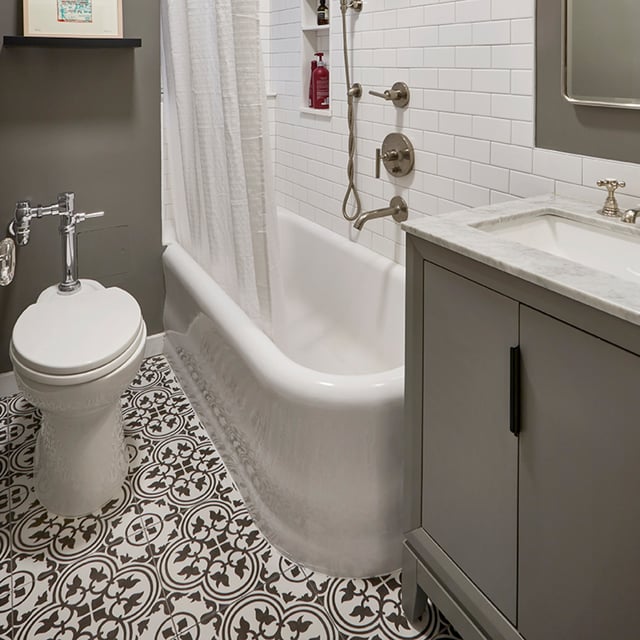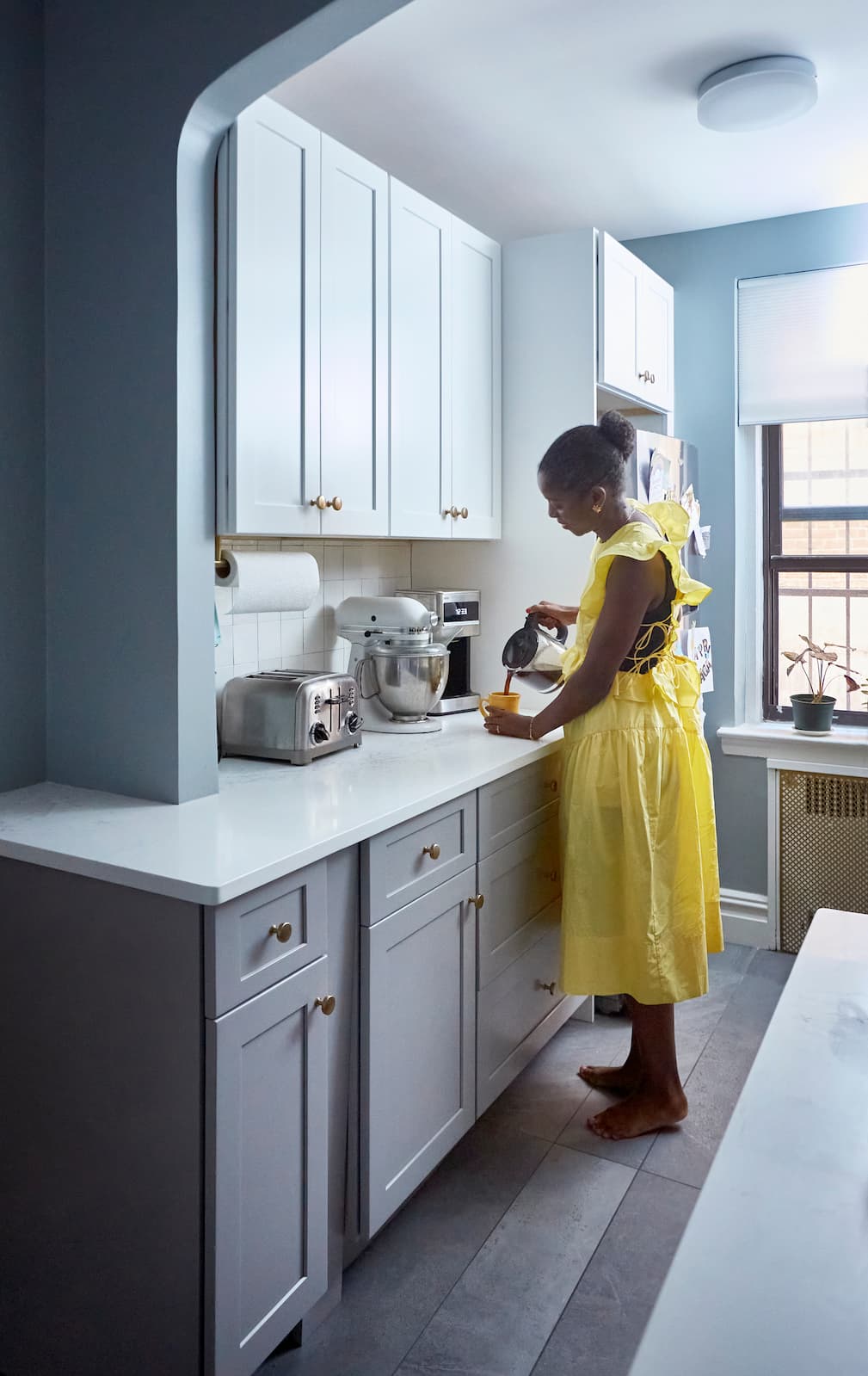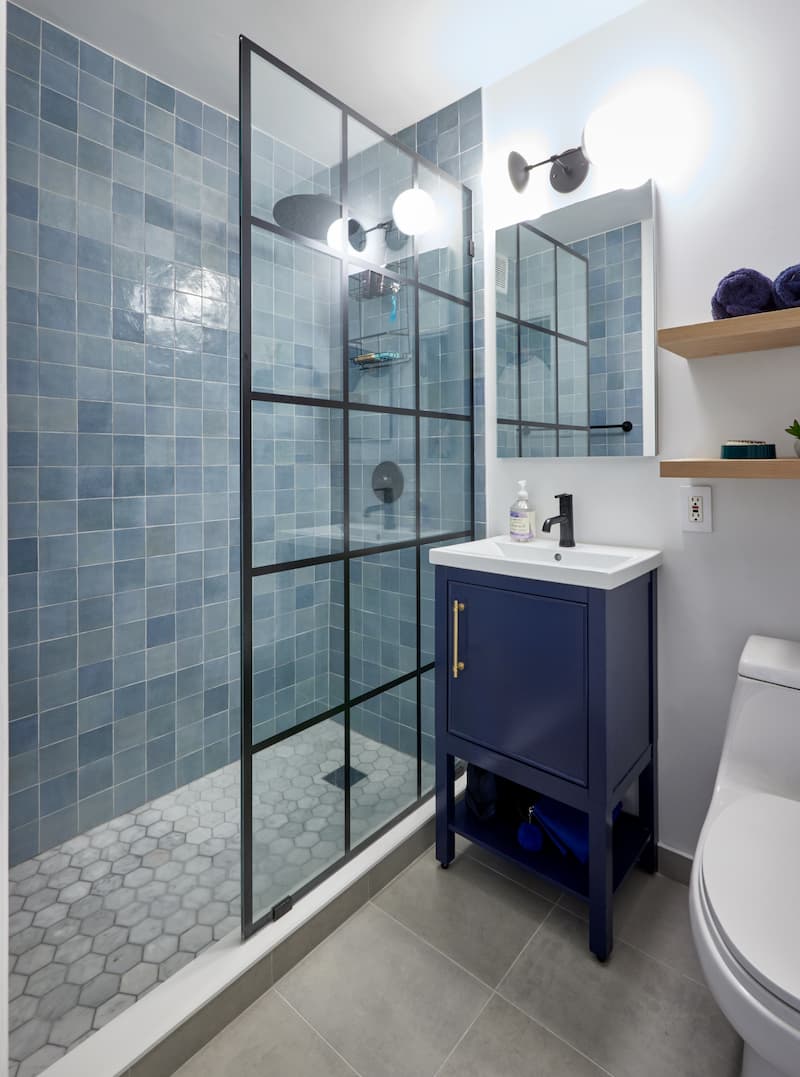
In This Article
No bathtub lasts forever. Fiberglass tubs typically hold up for 10 to 15 years, while more durable materials like porcelain can stretch to two decades or more. Still, age, wear, and water damage mean that most tubs will need repair or replacement at some point. It's not a matter of if—it’s when.
Visible cracks, extensive staining, and a dull, worn finish are all signs your tub is past its prime. If cleaning no longer restores its surface—or if you’re seeing rust or signs of leaking—it’s time to take action. But a full replacement isn’t your only path forward. You might consider:
Reglazing your tub: Reglazing is the process of applying a new, glossy coating over the existing surface of your bathtub to restore its shine and cover up stains, minor scratches, or discoloration. This method gives your tub a fresh appearance without the need for removal or major repairs.
Installing a bathtub liner: Installing a bathtub liner involves fitting a custom-made acrylic or PVC shell over your existing tub, creating a new, watertight surface without the need for demolition. This option is often chosen to quickly cover up stains, chips, or outdated colors while avoiding the mess and expense of a full replacement.
Refinishing your tub: Refinishing involves repairing chips, cracks, and other surface damage before applying a new finish to the tub. This process not only improves the tub’s appearance but also addresses minor structural issues, making it look and feel like new.
Before deciding between replacement, refinishing, or reglazing, it’s important to weigh all the factors—not just cost. While budget matters, cutting corners now can lead to bigger expenses and avoidable headaches down the line.
Bring Your Dream Bathroom to Life

Evaluating Your Tub’s Current State
Not all tubs can be saved with a cosmetic update. Signs that indicate a full tub replacement is needed include large or spreading cracks, significant rust or corrosion, persistent leaks, or structural instability. If your tub feels soft or flexes underfoot, or if repairs have become frequent and costly, replacement is likely the safest and most cost-effective solution.
On the other hand, if your tub is structurally sound but has surface stains, minor chips, or a dull finish, refinishing or reglazing can add several years to its lifespan—often extending usability by 5 to 10 years with proper care.
The material of the tub itself can shape your decision to replace or reglaze your tub; cheaper options like fiberglass will naturally have a reduced lifespan, while porcelain and cast iron can last much longer. Much like you wouldn’t want to invest in costly cosmetic repairs for a rundown car with hundreds of thousands of miles on its odometer, you may not want to invest in reglazing or adding a bathtub liner to a tub seemingly on its last legs.
If you’re unsure about the best course of action for your bathroom, consulting with an experienced contractor can provide valuable insight. A professional can assess your tub’s condition, discuss your goals and budget, and recommend the most practical and cost-effective solution for your home.
Costs of Reglazing vs. Refinishing vs. Replacing a Bathtub
Cost of Reglazing Your Tub
Reglazing is generally the most budget-friendly option, with total costs—including labor—typically ranging from $400 to $800. This process involves a professional applying a new surface coating to your existing tub, restoring its shine and covering minor imperfections. It’s a quick and cost-effective way to give your bathroom a fresh look without major renovation.
Most tub reglazing projects can be completed in a single day.
Cost of Refinishing Your Tub
Refinishing is a more involved process than reglazing, typically ranging from $500 to $1,200 with labor included. It goes beyond surface treatment by addressing chips, cracks, and other imperfections—resulting in a more durable, long-lasting finish. The higher cost reflects the added prep and repair work.
Like reglazing, most refinishing jobs can be completed by a professional in a single day.
Cost of Replacing Your Tub
Tub replacement is the most costly option, typically running between $2,000 and $6,000 or more when factoring in labor, demolition, disposal, plumbing, and installation. Final costs depend on the tub type, installation complexity, and any updates needed for plumbing or surrounding tile. Despite the price, replacement is often necessary for tubs with structural damage or as part of a full bathroom remodel.
The timeline varies: some installations wrap in a day, while others can stretch to three, depending on plumbing conditions, subfloor or wall repairs, and the style of tub being installed.
Additional Insights to Inform Your Decision
- With each time you refinish or reglaze your tub, expect diminishing returns. While it is possible to repeat these processes, the results may not be as durable or visually appealing as the original finish. Each additional layer can make it harder for new coatings to properly adhere, potentially leading to issues like peeling, chipping, or an uneven surface.
Over time, repeated refinishing or reglazing can result in a thicker, less attractive finish and a shorter lifespan for the tub’s surface. For this reason, it's rare that a tub is refinished or reglazed more than two or three times in the span of its lifetime. - Do you have a mold problem? Replacing the tub can let you address mildew and water damage. Persistent mold or mildew around your bathtub often signals deeper water damage beneath the surface. Simply refinishing or reglazing the tub won’t resolve hidden issues in the walls, subfloor, or plumbing.
By replacing the tub, you have the opportunity to inspect and repair any underlying damage, ensuring a healthier and safer bathroom environment. This approach can prevent future mold growth and protect your home’s structural integrity. Ultimately, replacement is the most thorough solution when mold or water damage is a concern. - Doing a full bathroom remodel? Now is the time to replace the tub. With walls and flooring likely being updated, removing and installing a new tub becomes much easier and more cost-effective than doing this project separately at a later time. This allows you to choose a tub that better matches your new design and meets your current needs.
Know the Cost Before You Start

- Extensive re-plumbing is also an opportune time to replace your tub. Major plumbing work often requires access to pipes behind and beneath the bathtub. If your bathroom is already undergoing extensive re-plumbing, replacing the tub at the same time can save on labor costs and prevent the need for future demolition. Coordinating these projects ensures your plumbing and fixtures are compatible and up to modern standards. Choosing to replace your tub at this time—rather than reglaze or refinish it—future-proofs your bathroom and avoids redundant work.
- Consider if your current tub meets the current and near-future needs of your family members. Your bathtub should suit the needs of everyone in your household, both now and in the years ahead. For example, families with young children may prefer a larger tub, while those with aging relatives might need an ADA-compliant version for their bathroom.
- Tubs are surprisingly diverse; consider if there’s a better design out there than what you currently have. Bathtubs are available in a variety of designs, each offering distinct features and benefits. For instance, a Japanese soaking tub is deeper and shorter than a traditional tub, allowing for a full-body soak in a compact space. Alternatively, a freestanding tub can serve as a focal point in the bathroom and offers flexibility in placement. Our point? You aren’t stuck with the tub you have.
- Converting your bathtub to a shower may have higher ROI in home sale value. In many markets, converting a bathtub to a walk-in shower can increase your home’s resale value, especially if you already have another tub elsewhere in the house. Showers are often more accessible, easier to clean, and preferred by many homebuyers. This conversion can also free up space, making your bathroom feel larger and more modern.
However, it’s important to consider your household’s needs and local buyer preferences before making the switch. Consulting with a real estate professional can help you determine if this upgrade will pay off in your area.

Warning: Do NOT Attempt to Refinish or Reglaze Your Tub Yourself
While very few non-professionals would attempt to replace a bathtub themselves, some homeowners may be tempted to DIY reglazing or refinishing. However, taking on these projects without professional experience can lead to several problems, including:
- Improper surface preparation: Inadequate cleaning or sanding can prevent the new finish from adhering properly, leading to peeling or chipping soon after application.
- Uneven or streaky finish: Achieving a smooth, even coat requires skill and the right tools; DIY attempts often result in visible brush marks, bubbles, or an inconsistent appearance.
- Exposure to hazardous chemicals: Many refinishing products contain strong fumes and chemicals that require proper ventilation and protective gear, posing health risks if not handled correctly.
- Voiding warranties: DIY work may void any existing warranties on your tub or bathroom fixtures, leaving you unprotected if issues arise later.
- Increase risk of damaging the tub: Using the wrong products or techniques can cause permanent damage to the tub’s surface, making it unsalvageable and necessitating a full replacement.
Conclusion
Choosing between reglazing, refinishing, or replacing your bathtub comes down to more than just cost—it’s about long-term value, safety, and how well your current setup meets your needs. A surface fix might buy you time, but in many cases, investing in a full replacement can solve deeper issues and better align with future goals. If you’re weighing your options, consult a professional who can help assess the condition of your tub, identify hidden risks, and recommend a solution that balances practicality with peace of mind.

Written by Block Renovation

Renovate confidently with Block
Easily compare quotes from top quality contractors, and get peace of mind with warranty & price protections.
Thousands of homeowners have renovated with Block

4.5 Stars (100+)

4.7 Stars (100+)

4.5 Stars (75+)
Renovate confidently
- Top quality contractors
- Warranty & price protections
- Expert resources

